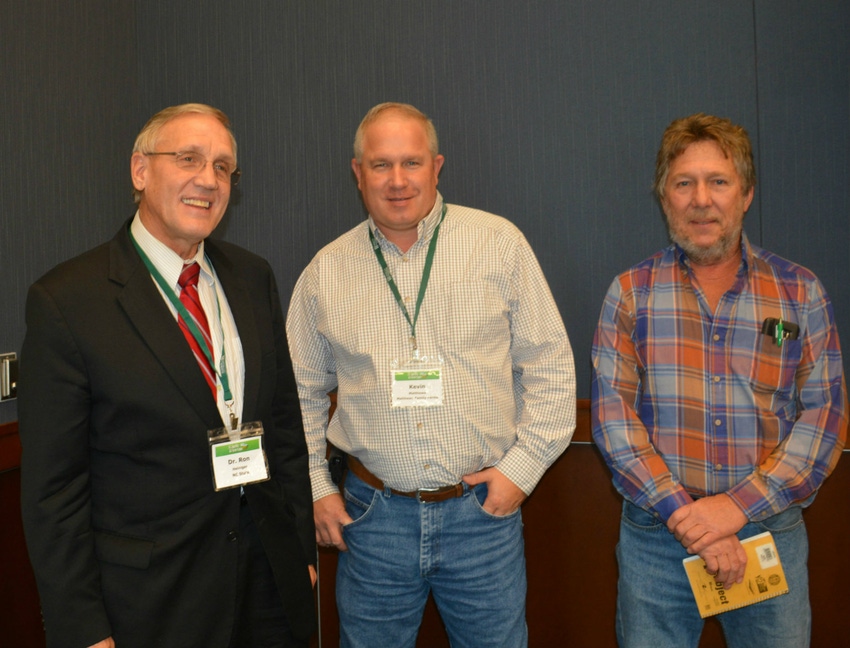
Thanks to low prices, soybean farmers will be watching every penny to make a profit this year. But to make a profit, you still need good yields, and increasing yields without increasing costs remains an ongoing challenge.
“We don’t have any extra money to spend in 2019. We have to be right,” says Yadkin County, N.C., farmer Kevin Matthews.
At this year’s SC AgriBiz & Farm Expo in Florence, Matthews and North Carolina State University Extension cropping systems specialist Dr. Ron Heiniger made a return appearance to offer pointers on adopting high yield soybean production practices. The two also spoke at last year’s expo, presenting the steps farmers need to take to maximize yields.
Additionally, Matthews won first place in the North Carolina Soybean Yield Contest for the second year in a row in 2018, once again breaking the 100-bushel per acre barrier with a yield of 104.5 bushels per acre.
For his 2018 award-winning entry of 104.5 bushels per acre, Matthews planted Pioneer 46A16R on April 21 at a rate of 140,000 seeds per acre. He planted full-season beans using no-till practices on irrigated land in 20-inch rows.
In winning the 2017 yield contest, Matthews, owner of Matthews Family Farms, became the first North Carolina soybean farmer to make a yield of more than 100 bushels per acre in the soybean yield contest with a yield of 107.4 bushels per acre, which bested the old contest record by 14.1 bushels per acre.
In their presentation at the expo, both Matthews and Heiniger agreed the key to maximizing yields without increasing costs is variety selection. The goal is to choose varieties and maturity groups that capture the maximum amount of light possible and timing your planting to ensure flowering by June 21, the summer solstice and longest day of the year.
Heiniger emphasizes the goal is to set more pods and get more fruit per node which can be achieved by getting more light during the flowering or reproductive period. He calls the method the “planting date, seeding rate, maturity group triangle.”
“Those three factors are going to determine how much light you get and how effective it is. The physiology of the soybean plant is that every trifoliate leaf attached to that node is critical because it supplies the main photosynthate, the sugars that are required for that flower to be effective and start setting a pod. We need light on every one of those nodes up and down the plant to make the yield. You need to get fruiting pods all the way up and down the plant. That’s your goal.”
Heiniger said goal one is to achieve flowering during the longest day of the year. Goal two is to achieve three feet tall plants with a canopy that are lapped in the middle of the row, a strategy North Carolina State’s recently retired Extension Soybean Specialist Dr. Jim Dunphy continually stressed.
“The reason for three foott tall beans is that we can be confident the light is falling on that canopy and will reach the lower leaves. What happens with a shoulder-tall bean? It lodges! There are no pods at the base of the plant because light never got there,” Heiniger said.
To achieve three foot tall soybeans plants that are lapped in the middle, Heiniger encourages a higher seeding rate planted in narrower-rows. The goal is to increase root mass in the soil. Maximizing pods per acre can be accomplished by more plants per acre and more nodes per plant.
Nutrient management is also a key factor in increasing pods. “Put nutrients at the root. That is the secret. Soybeans don’t have the root mass to go out and explore the soil like corn,” Heiniger said. Double inoculation is important.
“We get most of our nitrogen to soybeans through inoculation. By double inoculating, we found we got more nodules on those roots and nodules laterally along those roots. There’s a lot to be said about inoculation and nutrient placement. We have to find a way to do a better job of placing nutrients where they can get to the root system,” he said.
Like Heiniger, Matthews says variety selection will be job one for soybean farmers this year because profit margins will once again be incredibly narrow. He said selecting the right maturity for your farm and its geographic latitude will help you improve yields in dryland as well as irrigated systems. It’s all about capturing maximum sunlight.
In addition to capturing more light, nutrition, water management and pest management are vital to achieve top yields at a profit. “You have to be good stewards. You have to put your shadow in the field. You have to ask the right question: What is my yield limiting factor,” Matthews said.
As for nutrient management to achieve 100 bushel per acre yields, Matthews said it all depends on your soil type. Soil sampling and tissue sampling are critical to determine what nutrients in what amount your soybean plants need.
Matthews big yield limiting factor in his soil is phosphorous. For his irrigated soybeans, Matthews uses fertigation with nitrogen as his main driver. “Nitrogen particles can move through the plant so much easier. We get the phosphorous and potassium and micronutrients to travel with the nitrogen.”
For his dryland beans, Matthews uses a 2x2x2 system. In addition, he is a big fan of biologicals in both his dryland and irrigated production. “That microbial life is really important,” he said.
Molybdenum, boron and zinc are also important nutrients for maximizing yields. “Zinc is like candy to your soil. It feeds your microbes,’ Matthews said.
Cover crops and applying fertilizer up front is also important. “Cover crops work great in our soil,” Matthews said.
And to capture maximum light, Matthews likes to plant indeterminant varieties early, beginning early April. Matthews said for five years now, indeterminant varieties have delivered a 20 bushel per acre premium over determinant varieties.
“Indeterminants are better at our latitude on our farm on that plant date. In April, we don’t need to be planting Group IIIs. We need Group 4.9 or 4.9. When we get toward the 15th of May, we need to drop to a Group III,” Matthews said
Matthews plants his beans in 20-inch rows with a typical plant population of 125,000 to 130,000 seeds per acre, using an electric planter at a depth of 1.5 inches. All of his land is no-till.
“What I’m challenging you all to do is to get some plots on your farm and figure out what variety you need to plant at certain planting dates. That’s going to depend on your latitude. There’s a big difference in North Carolina from south of the border to Elizabeth City in latitude and growing season. And the same is true in South Carolina. There’s a big difference between Ridgeland, Hilton Head area to Florence and all the way up to Taber City from Florence,” he said.
Even with all the weather challenges in 2018, Matthews was able to average just shy of 60 bushels per acre on his 2,900 acres of soybeans. His typical farmwide average is 65 to 70 bushels per acre.
About the Author(s)
You May Also Like






